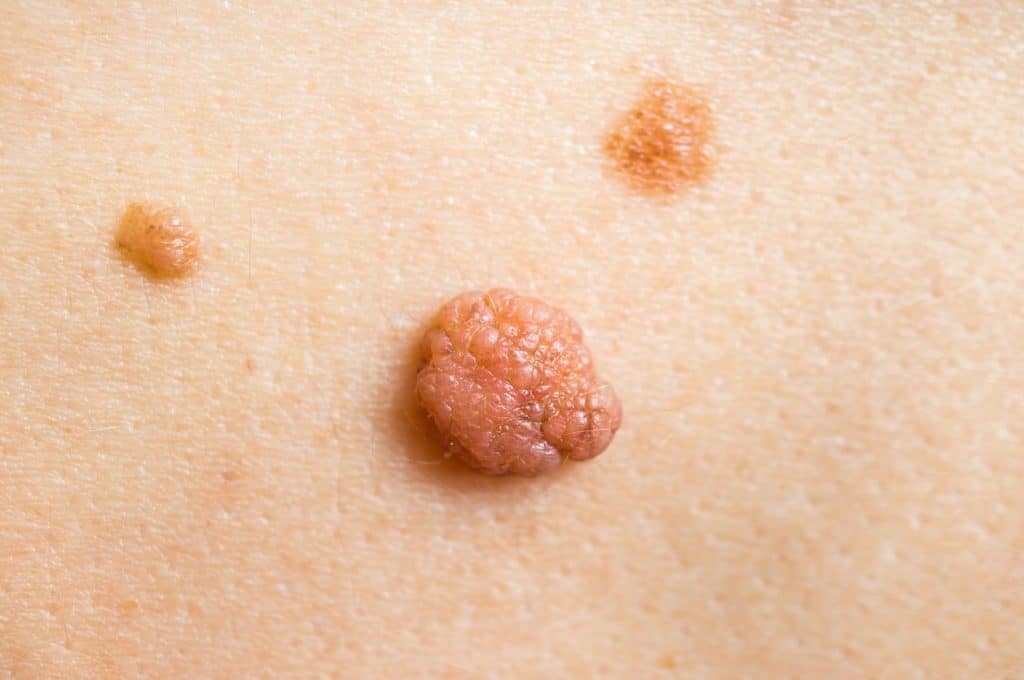
Moles come in all shapes and sizes; some raised and some flat. Almost every adult has moles; on average, we grow about 10 to 40 moles in our lifetimes. Those with lighter skin tend to have more moles. While moles are nothing much to worry about, you should know that:
Moles can appear anywhere on our bodies, from our scalp, palms, toes and even under our nails. They may not look alike and can differ in colour, size or shape. However, they often have these traits:
Melanoma, on the other hand, is slightly different. Moles with melanoma may often be irregularly shaped, larger than the size of say a pencil eraser or contain many colours. We usually refer to the ABCDEs when examining moles or skin growths to check for signs of melanoma.
Asymmetry
When your mole is asymmetrical, it means one half does not match the other. Normal moles are always symmetrical. To check for asymmetry, you may use a ruler or just draw an imaginary line through the middle of the mole. Compare the two halves — do they look the same or match up in terms of shape? If it doesn’t, have the mole checked by a dermatologist.
Border
Regular moles have well-defined borders, meaning the moles resemble complete circles. Irregular moles have borders or edges that are ragged or blurred — think scattered and looking somewhat like a blurry paint splat.
Colour
Irregular moles do not have the same colour throughout and usually contain shades of red, tan, brown, black, blue or white. If you have a mole of many shades or a mole that has lightened or darkened over time, you should get it checked by a doctor.
Diameter
A mole is suspicious if it’s larger than 6mm or the size of a pencil eraser.
Evolving
If a mole that wasn’t once raised is now raised, you should have it checked out by a doctor. The same goes for moles that shrink, change colour, itch or bleed. Essentially, moles that change in appearance over time are usually warning signs.

Raised moles may appear large and unsightly, but they are not always dangerous. As aforementioned in this article, raised moles are not necessarily signs of skin cancer. I would be worried if:
Regardless of whether your mole is cancerous or not, yes, it can be removed safely. This includes raised moles which require slightly more work — but still achievable nonetheless.
In Singapore, there are many cheap mole removal methods floating around. However, doctors often use one of three common mole removal methods:
Surgical excision is recommended for raised moles. This method requires cutting the mole out of the skin using a surgical instrument like a scalpel, electrocautery or an ablative laser. While surgical excision sounds intimidating, it is a simple procedure where the mole is removed through free-hand cutting or a special device. There will be a linear scar, but with good surgical skills and microsurgical techniques, scarring can be minimised.
Surgical shaving requires shaving the mole off the surface of the skin. This method is better for protruding moles that don’t grow too deep. Some textural change or discolouration is inevitable.
There are two types of laser treatments available: ablative and non-ablative pigment laser. Some common ablative lasers are the Erbium-Yag and CO2 lasers, which are well-liked among patients and doctors due to their ability to remove moles precisely without damaging other skin layers. Ablative lasers are often recommended for raised moles; I suggest using an ultrapulse CO2 laser first to flatten or remove the protruding mole, and then a pigment laser to get rid of any residual pigment. A few sessions may be required, but removing the raised portion of the mole usually requires just one session.
For flat moles, non-ablative pigment lasers may be a better option as ablative lasers may cause a scar or dent. However, growth factors can be injected to reduce the chances of scarring.
I hope this article gave you a better insight into moles. Remember to pay special attention to your moles, especially during pregnancy or menopause, when your hormones may be surging.
Address:
1Aesthetics, Medical & Surgery
#14-90 The Central Tower 1
8 Eu Tong Sen Street
Singapore 059818
Mon-Fri 10 AM to 730 PM
Sat 10 AM to 6 PM
Phone / WhatsApp:
+65 66125173 / +65 84899962
Email:
[email protected]